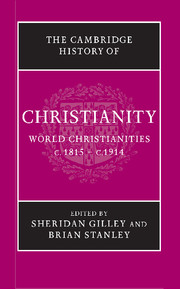Book contents
- Frontmatter
- 1 Introduction
- PART I CHRISTIANITY AND MODERNITY
- PART II THE CHURCHES AND NATIONAL IDENTITIES
- 14 Catholic Christianity in France from the Restoration to the separation of church and state, 1815–1905
- 15 Italy: the church and the Risorgimento
- 16 Catholicism, Ireland and the Irish diaspora
- 17 Catholic nationalism in Greater Hungary and Poland
- 18 Christianity and the creation of Germany
- 19 Anglicanism, Presbyterianism and the religious identities of the United Kingdom
- 20 Protestant dominance and confessional politics: Switzerland and the Netherlands
- 21 Scandinavia: Lutheranism and national identity
- 22 ‘Christian America’ and ‘Christian Canada’
- 23 Spain and Portugal: the challenge to the church
- 24 Latin America: the church and national independence
- 25 Between east and west: the Eastern Catholic (‘Uniate’) churches
- PART III THE EXPANSION OF CHRISTIANITY
- Select General Bibliography
- Chapter Bibliography
- Index
- References
22 - ‘Christian America’ and ‘Christian Canada’
from PART II - THE CHURCHES AND NATIONAL IDENTITIES
Published online by Cambridge University Press: 28 March 2008
- Frontmatter
- 1 Introduction
- PART I CHRISTIANITY AND MODERNITY
- PART II THE CHURCHES AND NATIONAL IDENTITIES
- 14 Catholic Christianity in France from the Restoration to the separation of church and state, 1815–1905
- 15 Italy: the church and the Risorgimento
- 16 Catholicism, Ireland and the Irish diaspora
- 17 Catholic nationalism in Greater Hungary and Poland
- 18 Christianity and the creation of Germany
- 19 Anglicanism, Presbyterianism and the religious identities of the United Kingdom
- 20 Protestant dominance and confessional politics: Switzerland and the Netherlands
- 21 Scandinavia: Lutheranism and national identity
- 22 ‘Christian America’ and ‘Christian Canada’
- 23 Spain and Portugal: the challenge to the church
- 24 Latin America: the church and national independence
- 25 Between east and west: the Eastern Catholic (‘Uniate’) churches
- PART III THE EXPANSION OF CHRISTIANITY
- Select General Bibliography
- Chapter Bibliography
- Index
- References
Summary
In the century from 1815 to 1914, the churches of North America experienced an expansion all but unprecedented in the modern history of Christianity. In an era of break-neck population growth (United States, from 8,400,000 to 99,100,000; Canada, from about 600,000 to about 8,000,000), rates of church adherence increased even more rapidly–in the United States from under one-fourth of the population to over two-fifths, and in Canada from an even smaller proportion at the start of the period to an even higher proportion at the end. Yet this era was just as noteworthy for how innovatively religion was being organised as for how rapidly the churches were growing. Christian believers in the United States gloried in their ‘freedom’, by which they meant they neither enjoyed nor sought the protection of establishment. In Canada, there was less enthusiasm about disestablishment, but by the second half of the century a similar state of affairs prevailed there. The self-starting efforts of denominations and the mobilisation of voluntary societies had taken the place of formal church–state ties, but the result was a more thorough Christianisation of the population than in Europe and an exertion of social influence at least as powerful as in the old world. In 1854 the learned Swiss émigré Philip Schaff returned to Europe and reported on his new land. Schaff granted that Americans had taken an unprecedented step in separating the churches from ‘the temporal power’, but insisted none the less that ‘Christianity, as the free expression of personal conviction and of the national character, has even greater power over the mind, than when enjoined by civil laws and upheld by police regulations.’ To Schaff, the proof could be discerned in practice:
- Type
- Chapter
- Information
- The Cambridge History of Christianity , pp. 359 - 380Publisher: Cambridge University PressPrint publication year: 2005
References
- 1
- Cited by

